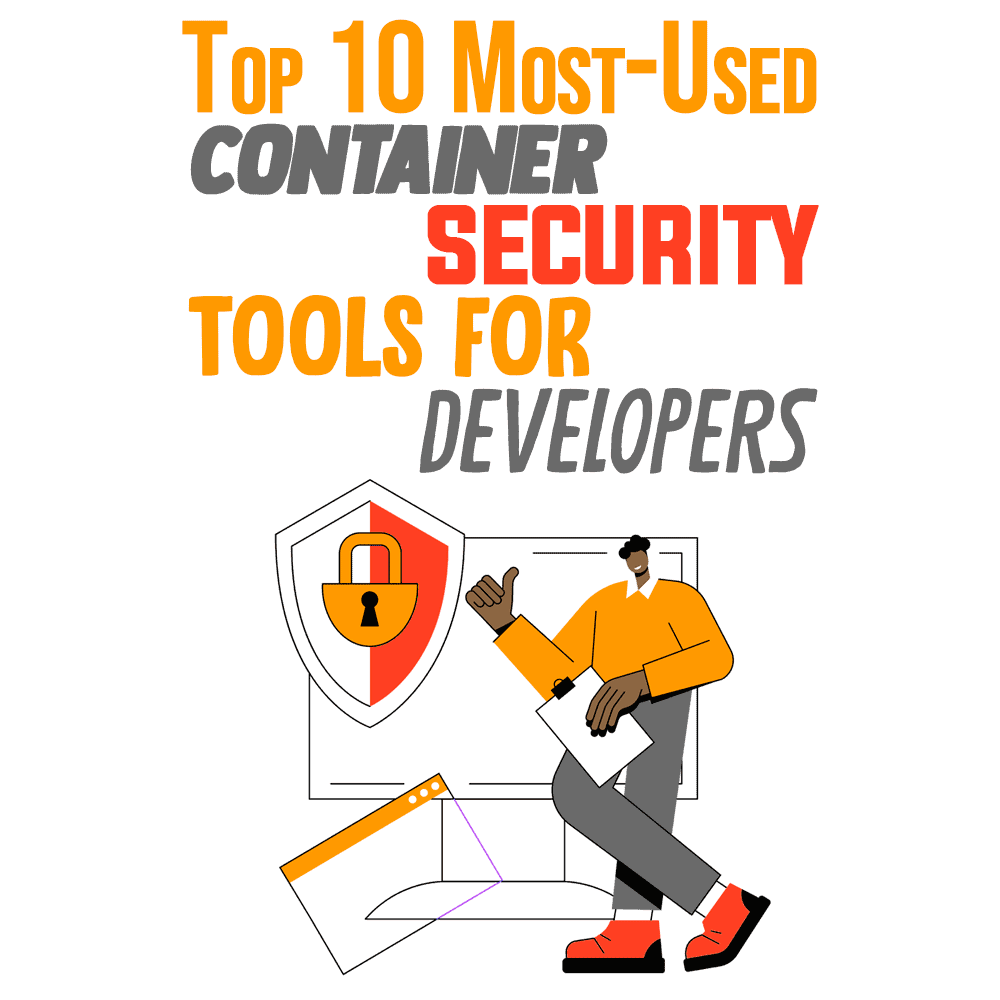 Containers have been one of the remarkable trends in the application development industry, as more organizations are opting for them to build, test, and deploy their applications faster without friction.
Containers have been one of the remarkable trends in the application development industry, as more organizations are opting for them to build, test, and deploy their applications faster without friction.
Containers are not inherently secure. Although containers come with in-built security features, they still need third-party tools for runtime and development environment protection. And with the continuously increasing cyberattacks on companies over the past few years, it has become essential to secure applications more than ever.
There are 10 great tools that can help you with container security. But before we talk about those, let’s start with some container basics.
What Do Containers and Containerization Signify?
Containerization is the packaging of software code with all its necessities like frameworks, operating system libraries, and other dependencies so that applications are isolated in their own “container.” Containerization is done so that the application within the container can be moved and consistently run in any environment or operating system.
Containers are an alternative to coding on one operating system or platform, which makes moving applications difficult. Containers act as a computing environment that surrounds the application and keeps it independent from its environment. Containers also offer a logical packaging mechanism to abstract applications from the environment they run in.
Containers are often referred to as “lightweight” because they share the operating system kernel of the machine and don’t need the overhead of operating systems associated with each application. What makes containers so popular is that they have an inherently smaller capacity than a Virtual Machine (VM), hence, require less time to start up, allowing more containers to run on the same compute capacity as one VM. This drives higher server efficiencies, while reducing licensing and server costs.
What Are the Threats in Containerization?
As containers have become a significant part of deploying applications, the necessity to secure them has risen accordingly. The real problem with securing containers is associated with their nature. Undoubtedly, code runs faster on containers, but its inner workings are invisible to operations.
Security challenges in containerization arise when the ops team unintentionally overlooks access control problems, threats, and other security issues and the container developers are unaware of the trouble points in their code.
Some of the common threat spots in a containerized environment are misconfigurations and exposures of container images, secrets, runtime privileges, control plane, namespaces, or runtime privileges; vulnerabilities like crypto mining, malware installation, or privilege escalation; runtime threats; and failed compliance audit.
What Is Container Security?
Container security is the process of securing containers against data leaks, malware, and other threats at different lifecycle stages of containers. From the time container images are built to when the container is loaded into the registry and deployed into the production environment, it’s a must to implement tools that can ensure the security of the container against potential threats.
To avoid any security conflicts, developers use container security tools that can scan vulnerabilities in the code during both the development and production stages. Container security tools help with network vulnerabilities monitoring and detection, incident response, and testing source code before and during production.
Some container security tools emphasize development, while others emphasize runtime security and threat mitigation.
Top 10 Container Security Tools
Container security tools manage access, test security, and protect cloud computing infrastructure that runs containerized applications. So here is the list of most used top container security tools that you can use to protect your container from security threats.
Qualys

Qualys Key Features:
- Incorporates policies to block use of vulnerability-specific images
- Identifies images with high vulnerabilities, older or test release tags, and unapproved packages
- Discovers and tracks containers and their images in a centralized manner
- Allows continuous detection for vulnerabilities in the DevOps pipeline by deploying plugins for CI/CD tools.
- Provides for identification of threats, impact assessment, and prioritization of remediation
Anchore
Anchore offers multiple solutions for container security, including Container Vulnerability Scanning, Container Registry Scanning, Kubernetes Images Scanning, and Container Compliance. Anchore automates container scanning for development environments, registries, CI/CD pipelines, or runtime environments through comprehensive APIs and CLI tools. Anchore also prevents the deployment of vulnerability prone images, using a Kubernetes admission controller.
Key Features:
- Provides accurate vulnerability feeds, a unique feedback loop, and optimized vulnerability matching to reduce false negatives and false positives
- With automated remediation workflows and recommendations, Anchore quickly views, manages, and fixes security vulnerabilities in container images
- Enforces policies to flag out of compliance images
- Provides security insights into containers in the registry using a tag, repo, or other metadata
- Monitors clusters of Kubernetes to detect vulnerabilities in active containers
- Embeds automatic compliance checks into CI/CD pipelines
Capsule8
Capsule8 identifies and stops undesired activity that can threaten the containerized environments on Linux systems. Threat models of Capsule8 work both on hosts and workloads of containers. Capsule8 also enables developers to create policies that leverage the metadata of a container.
Key Features of Capsule8:
- Capsule8 provides node protection that scales dynamically.
- Enables capabilities of Intrusion Prevention Systems (IPS), Antivirus and File Integrity Monitoring (FIM) with real-time protection, container awareness, visibility, and accountability in reporting.
- Shows privilege transition, process lineage, and process renaming to identify the impacted container.
- Protects orchestrators, container runtime, and cloud-native systems.
- Identifies unwanted activity on a per-container basis.
Sysdig
Sysdig’s container security stops known vulnerabilities at an early stage by integrating scanning into the registries and CI/CD pipelines. Sysdig identifies vulnerabilities at runtime, flags them, maps them back to applications, and detects the team that needs to fix the issue. Sysdig also helps developers in detecting malicious activities like insecure configurations, inside threats, leaked or weak credentials, and unpatched exploits at runtime and sends alerts.
Key Features:
- Identifies high severity OS and non-OS vulnerabilities, security bad practices, and misconfiguration
- Creates and maintains runtime detection policies
- Uses machine learning to automate profiling container images to avoid writing rules from scratch
- Provides on-demand dashboards, assessments, and reports for better third-party audits
- Maps compliance standards to certain controls for Kubernetes and container environments
Aqua Security
Based on a regularly updated stream of aggregate sources of vulnerability data, Aqua container security scans container images to ensure broad coverage while minimizing false positives. Aqua also helps in detecting malware, OSS licenses, embedded secrets, and configuration issues to reduce the chances of attacks.
Key Features:
- Provides dynamic container analysis.
- Identifies malware hidden in third-party images, open-source packages.
- Prevents container-based applications from credential thefts, data exfiltration, cryptocurrency mining, and other attacks.
- Creates flexible image assurance policies through static and dynamic scanning to decide images that will be allowed to go through the pipeline and run in the cluster.
- Aqua Risk Explorer shows real-time risk factors of namespace, application, node, and deployment in the Kubernetes cluster.
- Helps to mitigate risks and prioritize efficiency of remediation.
- Incorporates Drift Prevention and Runtime Policies.
Clair
Clair is an open-source tool that monitors container security using static vulnerability analysis in docker and appc. Clair is an API-based analysis engine that layer-by-layer scans containers for known security flaws. Clair gathers vulnerability data at intervals and stores them in a database, indexes the installed packages of software, and scrubs container images. In the case of matched vulnerabilities in the images, Clair sends reports and alerts or even blocks production environments deployments.
Key Features:
- Ingests vulnerability data sources like Red Hat Security Data, Debian Security Bug Tracker, and Ubuntu CVE tracker
- Provides comprehensive auditing
- Indexes list of features within a container image to help developers pass queries to the database for image related vulnerabilities
- Has a flexible feature set that can be customized according to the project requirements
Palo Alto Networks Prisma Cloud
Prisma Cloud continuously accumulates and prioritizes vulnerabilities in containers and CI/CD pipelines running on hosts, public, or private clouds or on a container as a service. Prisma Cloud scans the images in containers and imposes policies as a part of CI/CD workflows. It continuously monitors codes in registries and repositories while securing managed and unmanaged runtime environments.
Key Features:
- Establishes risk prioritization across remediation guidance, all-known common vulnerabilities and exposures (CVEs), and image analysis
- Maintains audit history
- Controls build and deployment based on custom policies and pre-built
- Implements proprietary checks and center for internet security (CIS) benchmarks
- Scans registries and repositories for misconfigurations and vulnerabilities
- Automatically detects anomalous behavior
Snyk
SNYK is a container security tool that is designed with developers in mind. SNYK examines Docker images for license violations and reports on vulnerabilities for each repository package. With SNYK, a developer can easily secure dependencies, code, containers, and infrastructure as a code. SNYK scanner identifies issues and advises remediation to fix those issues easily while SNYK verifies the updated code.
Key Features:
- Easily integrates with GitLab and GitHub
- Automates Open Source Security scanning
- Provides multiple integrations
- Provides quick scans of the codebase
- Includes CI/CD pipeline integrations
Threat Stack
Threat Stack container security solutions discover security and compliance risks within Kubernetes, containers, and AWS Fargate. Threat Stack provides real-time context for quick response. The container security solutions offered by Threat Stack can be deployed into a wide range of environments using machine images, configuration management tools, or daemonsets. Threat Stack implementation automates security coverage for your containers regardless of the workflow.
Key Features:
- Provides a single space to monitor containers, hosts, Kubernetes, cloud management console, and applications
- Provides deep visibility at the application level, within containers and the cloud management console
- Investigates incidents across infrastructure layers, providing full stack cloud security
NeuVector

Key Features:
- Provides continuous scanning throughout the lifecycle of a container
- Provides automated audit-ready assessments and reports on compliance
- Blocks both known and unknown threats
- Provides complete compliance scanning, vulnerability management, and admission controls over the CI/CD pipeline
- Creates a virtual wall to separate private and personal information on the network reports
Time To Secure Your Container
As containerization has evolved into a popular development style, the need to secure these containers with proper security tools is of high importance. These 10 tools that cover many different environments are here to solve the container security issues for your next project.
The strength of these tools depends on how deep you need your container security to be. So choose the tools that best fit your project, and make sure all your containers are secure.
